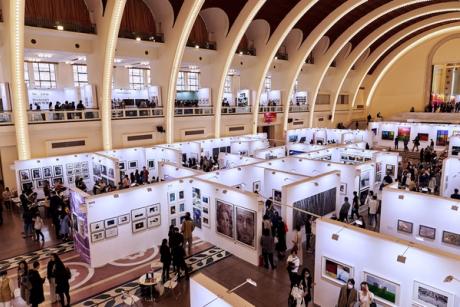
The return of Photofairs Shanghai (April 20-23) after a year-long hiatus is set to ride China’s “spring of revenge” from a fully reopened economy to the outside world. It is the first major mainland fair after China lifted its strict zero-Covid policy last December.
“We are lucky, in terms of timing,” says Fan Ni, director of Photofairs Shanghai. “Exhibitors also feel that this is a really good time.” She says Chinese galleries say sales after the Lunar New Year, from February to mid-March, rebounded from the same pre-lockdown period in 2022, “so they’re confident for April.”
The 30 participating galleries primarily based in China for this year include ShanghArt, Studio Gallery, Gaotai Gallery and A Thousand Plateaus Art Space. They are joined by several local associations including the Swatch Art Peace Hotel, Pro Helvetia Shanghai and the Miguel de Cervantes Library. Fotografiska, which will launch its first location in Asia on Shanghai’s Suzhou Creek waterfront later this year, will also have a booth. Among the photographic exhibitions that overlap throughout the city is the 20th anniversary retrospective of Shanghai’s Duolun Museum of Modern Art. A publishing section at Photofairs will feature 15 Chinese, Japanese and British companies offering photography books and magazines. “Traffic was low in 2021 due to Covid testing requirement [for admission]but even then, many publishers sold out,” says Fan.
This year, the fair also offered a reduced stand rate of $318 per square meter, instead of $445, for galleries under eight or bringing only artists under 35. The size of the fair still marks a reduction from pre-pandemic attendance of around 50 galleries, Fan says, as the lifting of Covid restrictions in December came too late for many galleries to plan. The 40% overseas attendance has dropped to a few galleries this year, and overseas attendees and collectors come, Fan says, “mainly from Hong Kong and Taiwan.” She says “the rest of the world still needs time” to get used to visiting China again. Further exhibitors include the 193 Gallery and Fisheye Gallery in Paris and the Yiwei Gallery in Los Angeles. “193 was excited to come to Shanghai even in November when it took quarantine,” Fan says.
V&E Art, based in Paris and Taipei, initially “hesitated because they were at [Shanghai fair] ART021 last year – not so pleasant experience,” says Fan. Last November, ART021 was closed after one day and some exhibitors were quarantined. The concurrent West Bund Art & Design fair was closed the following day after close contact with Covid. Two weeks later, as the zero Covid policy was lifted following nationwide protests, “they still finally signed up for Photofairs Shanghai because 2021 saw good sales for them,” Fan says. . “I don’t see any risk of fairs closing in China again. It’s safe to come here.
A permanent passage in the spring
This year marks the first time the fair has held in the spring since its debut in September 2014, a move that Fan says will be permanent. “Asia doesn’t have a lot of galleries devoted solely to photography,” she says. Most of the participants are therefore multi-format contemporary art galleries. “Usually fall has so many other museum fairs and exhibits so they prefer a less busy time.”
This fall, the founders of Photofairs will turn their sights to the United States, with the September launch of Photofairs New York. Photofairs San Francisco took place in 2017 and 2018 but closed after costing its owners $1 million. “Our goal has always been to return to the United States, the largest art and photography market in the world, with the East Coast at its center,” says Photofairs founder and CEO Scott Gray. Despite this, there were previously “no art fairs in New York devoted to contemporary fine art photography, digital art and video art,” he says. Fan envisions the fairs eventually creating a global conversation, starting with Chinese galleries already applying to New York. Gray says the company “strongly believes in the importance of Shanghai as a key international market for photographic and digital art in the Asia-Pacific region.”
